Baan, which opened this month, is a spirited new addition to the Thai culinary offerings in Taipei.
Headlined by chefs Thitid Tassanakajohn of Bangkok’s Le Du, and Richie Lin (林泉) of Taipei’s MUME, the collaboration marks Tassanakajohn’s overseas debut and caps off a momentous year for the rising chef, who steered his first restaurant to a star in the inaugural Michelin guide to Bangkok and 14th place among Asia’s 50 Best Restaurants.
Baan means “home,” and at its original Bangkok location, also run by Tassanakajohn, Baan distinguishes itself from its acclaimed fine-dining sibling with the promise of home-style Thai cooking drawn from family recipes.
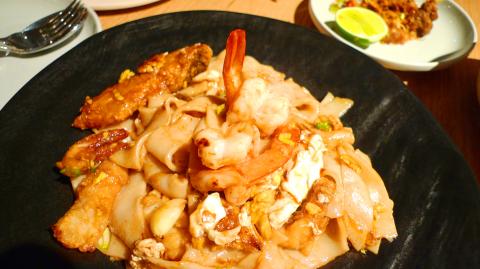
Photo: Davina Tham, Taipei Times
This concept translates well in Taipei, where Baan’s menu will meet and then exceed expectations with its familiar landing points of Thai cuisine — piquant papaya salads, variations on a coconut-based curry, pad thai tucked into an omelet — laid on a foundation of bold flavors that stretch the palate a little more toward the unknown.
Plates are meant for sharing, and that’s the way to go if you hope to sample a respectable selection from the menu. The cooking is confident, producing dishes that come together like a rambunctious family gathering, where relatives jostle and provoke each other as only family can. Heat plays a pivotal role in this love-hate relationship.
The signature braised beef in green curry (NT$480) lulls you in with tender brisket, lung and eggplant in a rich gravy, only for the chili to sneak up like a backhanded compliment from a distant relation. The heat is as impressive for its deviousness as for the fact that it does not upset the balance of flavors. For the price, I only wish that the beef came in heartier hunks.
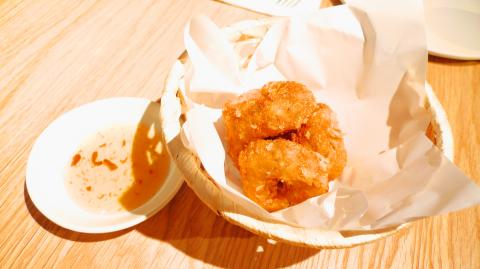
Photo: Davina Tham, Taipei
Seafood tom yum (NT$480) is a must-order that rules over the popular imagination of Thai cuisine like an indispensable matriarch. Knowing this, Baan stamps its individuality all over its version, which is more concentrated and built upon an assertive base of herbs and spices. The fiery hue intimidates at first, but its bark is worse than its bite. The chili is mild, although some might find the soup overpoweringly acidic. What does pack the heat are young chayote leaves stir-fried in oyster sauce (NT$220), which retain the crunch of a perfectly-cooked vegetable.
It is a sign of confidence — both in itself and its customers — that Baan has chosen not to turn down native levels of heat for the Taiwanese market. While this might bring pain to some, others like myself will appreciate the lack of condescension. Small chili icons on the menu indicate where the minefields are.
Aside from the classics, Baan provides a low-risk opportunity to make some less obvious choices. Consider moo kluk foon (NT$380), a pork stir-fry that eschews the usual accompaniment of holy basil for a delightfully unholy combination of fermented shrimp paste, bird’s eye chili lemongrass and lime. Its intense savoriness demands a bowl of organic jasmine rice (NT$60).
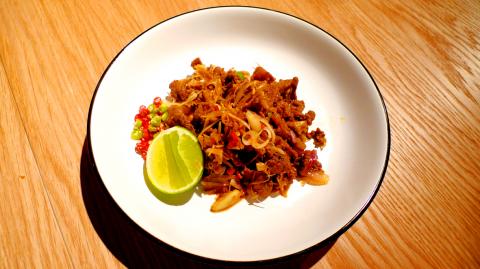
Photo: Davina Tham, Taipei
There are some underwhelming moments. An appetizer of deep-fried pork and prawn cakes (NT$380) would work up the appetite more if the sour plum dipping sauce — one of a few nods to Taiwanese ingredients — did not suffer from a curious lack of acidity. Stir-fried flat noodles with seafood (NT$380) are just good enough, though not as remarkable as their “signature” label implies.
The drinks department falters conspicuously, which in these early weeks can perhaps be put down to teething issues. Regardless of any drink orders, servers will inform you that it is mandatory for every table to order still or sparkling water (NT$60 per person). This can leave a bitter taste, especially if you are already intending to order other beverages like the iced Thai milk tea (NT$180).
The restaurant has partnered with Draft Land, a local purveyor of ready-made “cocktails on tap” by award-winning bartender Angus Zou (鄒斯傑), to provide four gin or rum-based cocktails featuring ingredients such as kaffir lime, ginger and lemongrass.
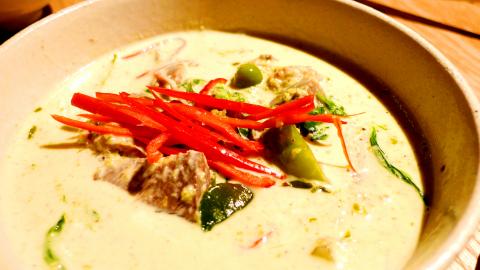
Photo: Davina Tham, Taipei
I pick “Chili” (NT$220), a mix of rum, mezcal, rosemary, chili and apple vinegar. When the colorless drink arrives in a glass with crushed ice and no garnish, I almost mistake it for iced water. The flavors are subdued, but the greater sin is the grossly missed opportunity for serving up some visual flair to complement the vibrant cooking. After all, you eat and drink with your eyes as much as your mouth.
The interior is tastefully decorated in shades of bamboo green and rattan brown, evoking an understated version of the Thai countryside. With its ambitious cooking and above-average prices, Baan is a special occasion destination that is unlikely to displace more easygoing and affordable Thai joints around the city.
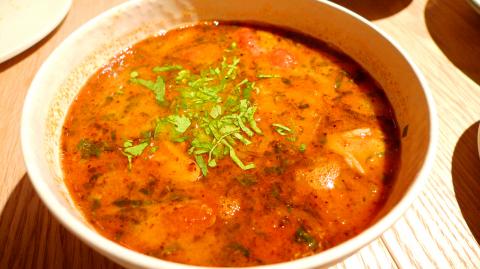
Photo: Davina Tham, Taipei

The Taipei Times last week reported that the rising share of seniors in the population is reshaping the nation’s housing markets. According to data from the Ministry of the Interior, about 850,000 residences were occupied by elderly people in the first quarter, including 655,000 that housed only one resident. H&B Realty chief researcher Jessica Hsu (徐佳馨), quoted in the article, said that there is rising demand for elderly-friendly housing, including units with elevators, barrier-free layouts and proximity to healthcare services. Hsu and others cited in the article highlighted the changing family residential dynamics, as children no longer live with parents,

Oct 20 to Oct 26 After a day of fighting, the Japanese Army’s Second Division was resting when a curious delegation of two Scotsmen and 19 Taiwanese approached their camp. It was Oct. 20, 1895, and the troops had reached Taiye Village (太爺庄) in today’s Hunei District (湖內), Kaohsiung, just 10km away from their final target of Tainan. Led by Presbyterian missionaries Thomas Barclay and Duncan Ferguson, the group informed the Japanese that resistance leader Liu Yung-fu (劉永福) had fled to China the previous night, leaving his Black Flag Army fighters behind and the city in chaos. On behalf of the

I was 10 when I read an article in the local paper about the Air Guitar World Championships, which take place every year in my home town of Oulu, Finland. My parents had helped out at the very first contest back in 1996 — my mum gave out fliers, my dad sorted the music. Since then, national championships have been held all across the world, with the winners assembling in Oulu every summer. At the time, I asked my parents if I could compete. At first they were hesitant; the event was in a bar, and there would be a lot

Smart speakers are a great parenting crutch, whether it be for setting a timer (kids seem to be weirdly obedient to them) or asking Alexa for homework help when the kids put you on the spot. But reader Katie Matthews has hacked the parenting matrix. “I used to have to nag repeatedly to get the kids out of the house,” she says. “Now our Google speaker announces a five-minute warning before we need to leave. They know they have to do their last bits of faffing when they hear that warning. Then the speaker announces, ‘Shoes on, let’s go!’ when